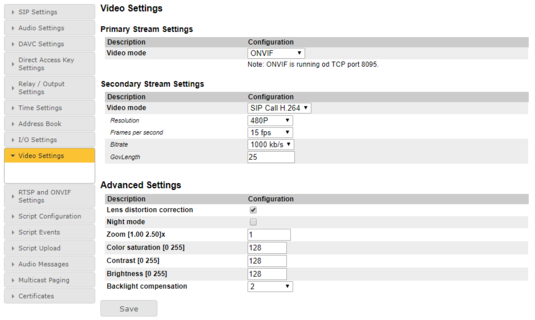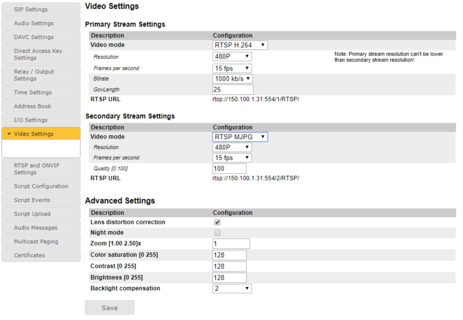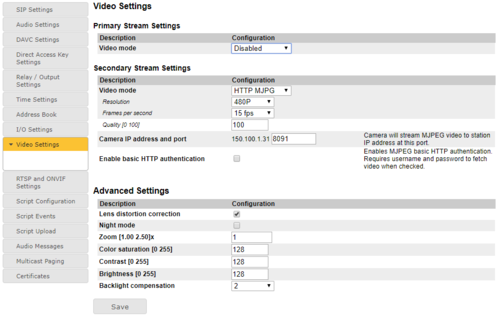Turbine Video Settings
From Zenitel Wiki
To modify the video settings on the station models TCIV-2, TCIV-3 or TCIV-6, log on to the station web interface and select:
- Advanced AlphaCom > Video (AlphaCom mode), or
- SIP Configuration > Video Setting (SIP/Pulse mode)
What settings and options are available will depend on what firmware is used in the TCIV station.
Video Settings - Firmware version 4.11
This section describes the Video Settings used in firmware 4.11.
Video mode
The Video mode parameter defines how each of two supported video streams will be used.
- For turning off video stream Disabled option should be chosen.
- When ONVIF option is used, all video configurations is managed by external ONVIF Profile S compliant software - Video Management System. ONVIF media profiles can additionaly be managed on RTSP and ONVIF Settings page.
- When RTSP H264 option is used, RTSP stream in H.264 format will be available on URI rtsp://[IP address of the camera]:554/1/RTSP
- When RTSP MJPG option is used, RTSP stream in MJPEG format will be available on URI rtsp://[IP address of the camera]:554/1/RTSP
- When SIP Call H.264 option is used, video stream in H.264 format will be visible in SIP/Pulse calls.
- When HTTP MJPG option is used, video stream in MJPEG format is available on this url: http://<IP address of the camera>:8090
In RTSP H264 and RTSP MJPG URL, TCIV is using default port 554. The port number is configurable and it can be changed on RTSP and ONVIF Settings page. In the same URL number 1 or 2 determines URL for primary and secondary stream respectively.
In HTTP MJPG URL, TCIV is using default port 8090 for primary and 8091 for secondary stream. The port number is configurable, but it should be different for each stream (if both streams use the same HTTP MJPG option).
- Video Settings 4.11
Video Settings
- Resolution: Sets the pixel resolution
- Frames per second: Sets the framerate per second.
- Bitrate [RTSP H264/SIP Call H.264]: Sets the bitrate which will be used in video stream
- GovLength [RTSP H264/SIP Call H.264]: Interval in which the I-frames will be coded
- Quality [RTSP MJPG/HTTP MJPG]: Image quality in percentage
- RTSP URL [RTSP MJPG/HTTP MJPG]: RTSP URL that can be used for streaming video in RTSP player
- Camera IP address and port [HTTP MJPG]: HTTP URL that can be used for streaming video
- Enable basic HTTP authentication [HTTP MJPG]: Requires username and password to fetch video when checked (default admin/alphaadmin).
Limitations
- Only one stream can use SIP Call H.264 option
- Only one stream can use ONVIF option
- SIP Call H.264 option is not available in Alphacom mode
- Each MJPG stream can stream only one simultaneous video stream
- Primary stream resolution needs to be higher or equal to secondary stream
Video Settings - Firmware version 4.7 and 4.9
This section describes the Video Settings used in firmware 4.7 and 4.9. Older versions might differ somewhat.
- Video Settings 4.7
Video settings
- Video Mode: Defines whether the video stream will be MJPG in http or H.264 in RTP.
- When the TCIV station is used in SIP or Pulse mode, you can choose to use either H.264 or MJPEG.
- When the TCIV station is used in AlphaCom mode, the station uses video mode MJPEG.
- In MJPEG the url to stream video is: http://<IP address of the camera>:8090/mjpg/video.mjpg
- Example: http://10.5.101.49:8090/mjpg/video.mjpg (The TCIV is by default using port 8090 for video. The port number is configurable, see below).
- Enable Video: This parameter defines whether calls made from the station will be video calls.
- Resolution: Sets the pixel resolution.
- Frames per second: Sets the framerate per second.
- Bitrate [H264 only]: Sets the bitrate which will be used in video stream.
- Camera IP address and port [MJPG only]: This is the IP address and port number (default is port 8090) of the camera streaming the video to a web browser or video display station. The video camera and the Turbine station have the same IP address.
- Enable HTTP basic authentication [MJPG only]: Requires username and password to fetch video when checked (default admin/alphaadmin).
- Video setup mode: Sets how the video will be established, there are two options available:
- Default - this option should be used if the station is used with AlphaCom, Pulse, or non-Cisco 3rd party SIP server
- Cisco - this option should be set if the station is used with Cisco Call Manager. This will force 25 fps framerate.
MJPG client connections limitation
If video mode is set to MJPG, the station will enforce a limit of maximum available simultaneous MJPG streams (client connections). This limit is dependent on the set resolution.
- Resolution 240P: Max. 3 simultaneous MJPEG streams
- Resolution 480P: Max. 2 simultaneous MJPEG streams
Advanced Settings (all versions)
- Lens distortion correction: Enabling this parameter will correct the “fish eye” effect that can occur on the edges of the video image.
- Night mode: Enables night mode when checked
- Zoom: This parameter sets the digital zoom of the video image. The zoom level range is 1.0 to 2.5. Once it is set higher than 1.0 it allows for offsetting the view horizontally and vertically. The offset range is -100 to 100.
- Offset Left Right: Available when zoom is set to more than 1x. Determines the width of the image.
- Offset Up-Down: Available when zoom is set to more than 1x. Determines the height of the image.
- Color saturation: This parameter sets the color saturation of the video image. The range is from 0 to 255. The default value is 128.
- Contrast: This parameter sets the contrast of the video image. The range is from 0 to 255. The default value is 128.
- Brightness: This parameter sets the brightness of the video image. The range is from 0 to 255. The default value is 128.
- Backlight compensation: This parameter sets the backlight compensation for the video image. The range is from 0 to 5. The default value is 2.






